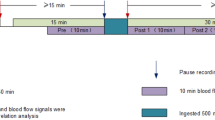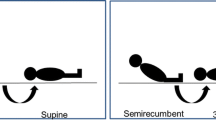Abstract
Purpose
The pathophysiology of the pregnancy-induced hypertension is still poorly understood, especially with regard to the central autonomic nervous system control and peripheral vascular factors.
Methods
Our study therefore aimed to investigate simultaneously the responses of blood pressure, heart rate, heart rate variability (HRV), and laser-Doppler (LD) flux to local cooling in healthy non-pregnant women (N = 12), in pregnant women with normal pregnancy (N = 16) and in women with gestational hypertension (N = 10).
Results
The direct and indirect LD flux responses to local cold exposure were diminished in normotensive pregnant females (Dunnett’s test, p < 0.05) when compared to non-pregnant females with normal menstrual cycle, but not in females with pregnancy-induced hypertension. In addition, blood pressure increased and heart rate decreased during cold exposure only in normotensive pregnant females, but not in pregnant hypertensive females (paired t test, p < 0.05). Simultaneously calculated heart rate variability total power of HRV and LF power values typically increased during local cold provocation test in non-pregnant females and in normotensive pregnant females (paired t test, p < 0.05). In hypertensive pregnant females HRV indices remained unchanged.
Conclusion
Our results indicate that the cardiovascular reactivity adaptation seen in normal pregnancy is absent in gestational hypertension.



Similar content being viewed by others
References
Anumba DO, Robson SC, Boys RJ, Ford GA (1999) Nitric oxide activity in the peripheral vasculature during normotensive and preeclamptic pregnancy. Am J Physiol 277(2 Pt 2):H848–H854
Avery ND, Wolfe LA, Amara CE, Davies GA, McGrath MJ (2001) Effects of human pregnancy on cardiac autonomic function above and below the ventilatory threshold. J Appl Physiol 90(1):321–328
Beinder E, Schlembach D (2001) Skin flux during reactive hyperemia and local hyperthermia in patients with preeclampsia. Obstet Gynecol 98(2):313–318
Blake MJ, Martin A, Manktelow BN et al (2000) Changes in baroreceptor sensitivity for heart rate during normotensive pregnancy and the puerperium. Clin Sci (Lond) 98(3):259–268
Bowyer L, Brown MA, Jones M (2003) Forearm blood flow in pre-eclampsia. BJOG 110(4):383–391
Cankar K, Finderle Z, Strucl M (2004) The role of alpha1- and alpha2-adrenoceptors in gender differences in cutaneous LD flux response to local cooling. Microvasc Res 68(2):126–131
Carbillon L, Uzan M, Uzan S (2000) Pregnancy, vascular tone, and maternal hemodynamics: a crucial adaptation. Obstet Gynecol Surv 55(9):574–581
Chamchad D, Horrow JC, Nakhamchik L, Arkoosh VA (2007) Heart rate variability changes during pregnancy: an observational study. Int J Obstet Anesth 16(2):106–109
Diejomaoh FM, Omu AE, Al-Busiri N et al (2004) Nitric oxide production is not altered in preeclampsia. Arch Gynecol Obstet 269(4):237–243
Dørup I, Skajaa K, Sørensen KE (1999) Normal pregnancy is associated with enhanced endothelium-dependent flow-mediated vasodilation. Am J Physiol 276(3 Pt 2):H821–H825
Faber R, Baumert M, Stepan H, Wessel N, Voss A, Walther T (2004) Baroreflex sensitivity, heart rate, and blood pressure variability in hypertensive pregnancy disorders. J Hum Hypertens 18(10):707–712
Foong LC, Chong YS, Chua S, Johnson P, De Swiet M (2000) Impaired vasoconstriction in pregnancy-induced hypertension assessed using doppler fluximetry. Obstet Gynecol 95(4):491–495
Gilbert JS, Ryan MJ, LaMarca BB, Sedeek M, Murphy SR, Granger JP (2008) Pathophysiology of hypertension during preeclampsia: linking placental ischemia with endothelial dysfunction. Am J Physiol Heart Circ Physiol 294(2):H541–H550
Gillham JC, Kenny LC, Baker PN (2003) An overview of endothelium-derived hyperpolarising factor (EDHF) in normal and compromised pregnancies. Eur J Obstet Gynecol Reprod Biol 109(1):2–7
Hasan KM, Manyonda IT, Ng FS, Singer DR, Antonios TF (2002) Skin capillary density changes in normal pregnancy and pre-eclampsia. J Hypertens 20(12):2439–2443
Kashiwagi M, Zimmermann R, Beinder E (2003) Pathophysiology of pre-eclampsia: update on the role of nitric oxide. Curr Hypertens Rep 5(6):493–497
Khan F, Belch JJ, MacLeod M, Mires G (2005) Changes in endothelial function precede the clinical disease in women in whom preeclampsia develops. Hypertension 46(5):1123–1128
Malik M (1996) Heart rate variability: Standards of measurements, physiological interpretation, and clinical use. Circulation 93:1043–1065
Matsuo H, Inoue K, Hapsari ED, Kitano K, Shiotani H (2007) Change of autonomic nervous activity during pregnancy and its modulation of labor assessed by spectral heart rate variability analysis. Clin Exp Obstet Gynecol 34(2):73–79
Minson CT, Halliwill JR, Young TM, Joyner MJ (2000) Influence of the menstrual cycle on sympathetic activity, baroreflex sensitivity, and vascular transduction in young women. Circulation 101(8):862–868
Rang S, Wolf H, Montfrans GA, Karemaker JM (2002) Non-invasive assessment of autonomic cardiovascular control in normal human pregnancy and pregnancy- associated hypertensive disorders: a review. J Hypertens 20(11):2111–2119
Roberts JM (2008) Preeclampsia: new approaches but the same old problems. Am J Obstet Gynecol 199(5):443–444
Shah DM (2007) Preeclampsia: new insights. Curr Opin Nephrol Hypertens 16(3):213–220
Silver HM, Tahvanainen KU, Kuusela TA, Eckberg DL (2001) Comparison of vagal baroreflex function in nonpregnant women and in women with normal pregnancy, preeclampsia, or gestational hypertension. Am J Obstet Gynecol 184(6):1189–1195
Stein PK, Kleiger RE (1999) Insights from the study of heart rate variability. Annu Rev Med 50:249–261
Stephens DP, Bennett LA, Aoki K, Kosiba WA, Charkoudian N, Johnson JM (2002) Sympathetic nonnoradrenergic cutaneous vasoconstriction in women is associated with reproductive hormone status. Am J Physiol Heart Circ Physiol 282(1):H264–H272
Vollebregt KC, Boer K, Mathura KR, de Graaff JC, Ubbink DT, Ince C (2001) Impaired vascular function in women with pre-eclampsia observed with orthogonal polarisation spectral imaging. BJOG 108(11):1148–1153
Yang CC, Chao TC, Kuo TB, Yin CS, Chen HI (2000) Preeclamptic pregnancy is associated with increased sympathetic and decreased parasympathetic control of HR. Am J Physiol Heart Circ Physiol 278(4):H1269–H1273
Yvonne-Tee GB, Rasool AH, Halim AS, Rahman AR (2006) Noninvasive assessment of cutaneous vascular function in vivo using capillaroscopy, plethysmography and laser-Doppler instruments: its strengths and weaknesses. Clin Hemorheol Microcirc 34(4):457–473
Acknowledgments
The authors would like to thank prim. Dr. P. Res, specialist of Obstetrics and Gynaecology and Health Centre Dravlje for contribution to present study. The study was supported by Ministry of Higher Education, Science and Technology (Grant No.: PO-510-381), Slovenia.
Author information
Authors and Affiliations
Corresponding author
Rights and permissions
About this article
Cite this article
Cankar, K., Potocnik, N. & Strucl, M. Alteration of skin laser-Doppler flux response to local cooling in gestational hypertension. Clin Auton Res 20, 183–190 (2010). https://doi.org/10.1007/s10286-009-0050-1
Received:
Accepted:
Published:
Issue Date:
DOI: https://doi.org/10.1007/s10286-009-0050-1




